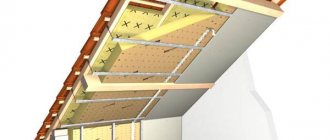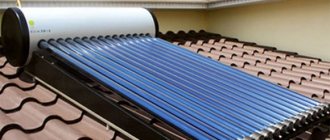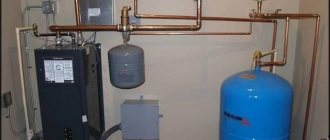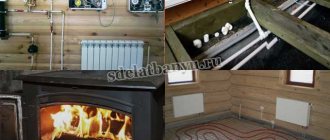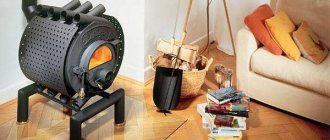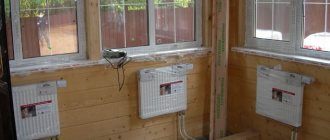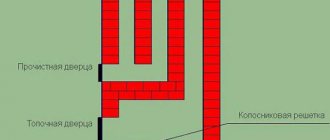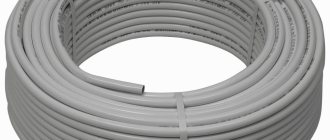For many, the dacha is a favorite vacation spot, where they can at least temporarily get away from the noise and bustle of the city. For others, it is a place of permanent residence, including in winter. But the word dacha can mean a variety of concepts - it can be a small house in a gardening partnership, a country house in a cottage village, or a private house in a village. Depending on what is considered a dacha, its location and the living conditions available there, you need to make a decision on how to make heating in your dacha with your own hands.
A country house with heating will be a wonderful place to relax in winter
Heating selection
First of all, it is important to decide what the heating system will be used for. The main task, of course, is to heat the country house and maintain a temperature comfortable for living. In addition, heating can be used in the country for:
- baths or heating water for showers;
- cooking and boiling water;
- drying fruits and vegetables for the winter;
- drying clothes and shoes necessary in the damp autumn or spring period.
Connecting to the pipe
If a residential complex or gardening association is gasified and the pipe runs along the border of the site, the choice in favor of a centralized system is usually obvious. It's not that simple though. Before submitting an application for connection, you should clarify the gas pressure in the line and the permissible volume of its intake. The fact is that gas distribution projects in many old settlements were created in conditions when kitchen stoves were the only points of consumption.
Gas at the dacha
If you plan to use gas in heating and water heating systems, as fuel for backup electric generators, the required volume may go far beyond the initial calculated values of the local network.
The installation procedure for a central gas supply system is relatively simple and does not take much time. First, craftsmen lay an underground line of plastic gas pipes from the nearest gas distribution point to the house; in some cases, it may be necessary to tap into the gas pipeline. Gas is brought inside the cottage through a special cabinet with a reducer to reduce the pressure. Then they install the pipework inside the house, carry out commissioning and handover and acceptance of the system in the presence of inspectors from Rostechnadzor and the gas distribution organization.
Gas at the dacha
By the way, installation and launch of the gas supply system is the final and easiest stage. The lion's share of time, effort and finances is spent on coordinating the project with various authorities and preparing documentation. Visiting the thresholds of bureaucratic offices can sometimes last for six months.
In general terms, the procedure will look like this. First, you need to obtain technical conditions for gasification from the regional gas distribution organization (in the Moscow region it is the State Unitary Enterprise Mosoblgaz). The application must be accompanied by copies of documents confirming land ownership, a site plan and thermal engineering calculations indicating all gas consumption points and total gas consumption. Then it is necessary to develop a project and create a drawing of the future highway. To assess the work conditions and draw up an estimate, an engineer from the design organization must visit the site. After this, the project may need to be approved by the environmental protection services, fire inspection and architectural department, as well as its registration with Rostechnadzor. After these ordeals are completed, it is necessary to conclude a supply agreement with Mosoblgaz and make an advance payment for the next year. And only then the installation company begins installing the entire system.
The minimum cost of connecting to the highway is 100 - 130 thousand rubles, and the upper price limit can reach 200 - 250 thousand rubles.
Types of systems
Heating in a country house, the choice of energy sources and the installation of a heating system depend on various factors. These include communications connected to the house (water, gas, electricity), and the layout of the house, and the building materials from which the building is constructed, and the number of residents, and the frequency of visits to the summer cottage.
There are several options for a home heating system, depending on the energy carriers used in the house:
- gas heating;
- electric heating with or without water heating;
- wood stove, fireplace;
- heating boilers;
- solid fuel or light fuel heating units.
Gas equipment
The most economical and efficient option is gas boilers. But the savings only appear with year-round use. The gas is burned and converted into thermal energy in a gas boiler, which, using a pump, supplies the heated coolant to the heating radiators. Gas equipment is fully automated and equipped with a control system, so you don’t have to worry about your country house during your departure.
To connect to the central gas main, you need to obtain many permits and install a meter. All this requires certain costs and time.
If it is not possible to connect to the central network, you can use gas in cylinders. But at the same time you need to constantly monitor the fuel level and change it periodically.
A group of cylinders is connected to the boiler through a reducer . This design is the most economical. If it becomes possible to connect to the central gas pipeline network, then this will not be difficult, you just need to slightly re-equip the system. But even such a connection scheme requires permission from the gas service and connection of the meter. If this is not done, then unauthorized connection will result in large fines for the summer resident.
Electric heating of the house
Another way to heat your home is electric. This option is not the cheapest, but the most accessible - electricity is available in every home. Electrical equipment is compact in size and fits perfectly into the interior of the house, and installation and maintenance of such a system require a minimum of time.
An economical option for heating a dacha is an electric boiler with water heating . You can also install a separate individual electric heater in each room, but this will certainly be more expensive. Water heating works on the same principle as gas heating.
Heating a dacha with an electric heater is not the best option, because you will have to heat all the rooms at once, and this will lead to a large consumption of electricity. So let's consider a more economical option - electric boilers.
Both conventional water radiators and a “warm floor” system can act as electric heating. Electric boilers are silent, do not emit smoke, combustion products or odor, have any level of safety - fire, electrical, chemical, etc. And you also do not need to obtain permission to connect the system.
The disadvantages include high energy consumption. The power of electric boilers usually reaches 3.5−7 kW, electric heaters 1.2−2 kW. For them, you need to build a separate electrical panel, connect RAM and other devices.
Alternative options
There are many alternative heating options to electric boilers and electric heaters. Some of them may be more economical, but almost all are used periodically - when residents come to their summer cottage.
One of the most profitable options is infrared emitters. They heat objects in the room, which then give off heat. The objects also include walls, which helps to heat a large area. Most often, such heaters are installed closer to the ceiling.
Electric fireplace. It will not be difficult to install it, and, in addition, no special permits, skills or knowledge are required. You can place it in any room without restrictions. The main advantages of electric fireplaces:
- no need to build a chimney to remove combustion products;
- do not require much space, because they are built into the wall;
- in summer you can enjoy imitation fire;
- there are many models of fireplaces suitable for different interiors;
- mobile, can move to any place (for example, after repair);
- The power consumed by the fireplace, as a rule, does not exceed 2 kW.
Heating convectors. This type of heating can be used in any room, has small dimensions and an original design. The design is very simple, making it easy to install and maintain. They evenly heat the air in the room, which does not require a lot of energy resources and helps save money. You can create a system of convectors to provide heat to the entire country house.
The average price of a convector fluctuates around 3 thousand rubles. It has a thermostat and a heat sensor, which ensures high-quality operation of the device. The maximum heating temperature reaches +80 degrees. The device is completely safe, so you don’t have to worry about getting burned.
Alternative heat sources include water convectors. They come in three types:
- Wall mounted . The most popular option. It is lightweight and therefore can be attached anywhere.
- Floor-standing . The only difference from wall-mounted ones is the mounting of the device.
- Embedded . This model solves two problems at once - heating and design.
Oil electric heaters. Such devices consume more electricity than others, because they have a greater heating inertia. But they also cool down more slowly than other electrical appliances, and do not consume electricity. There are mobile and stationary versions of the device. They are most often used to warm up one room. Many radiator models have several operating modes that can be used to adjust the heating intensity.
Electric ventilation units are an excellent option for heating a room. They are quite cheap and quickly warm up the room using air supplied from the coil using a fan. The disadvantages of the device include air drying and noisy operation.
Stove heating
This heating of a country house can be called one of the most reliable options. It can be used as a main or additional type of heating. There is no need to connect lines to the stove - you only need to take care of a supply of coal and firewood. If there is no electricity at the dacha, then the stove will help you cook food, heat water and even bake bread.
Depending on the size of the room, you can choose the stove size and material required. You can also build a brick oven with your own hands, which will have compact dimensions and an elegant design. If it is not possible to build a stove yourself, you can purchase a ready-made option - a cast iron stove. Both brick and cast iron stoves can have different functionality:
- only heat the house;
- can both heat the house and have an oven, hob or water heating tank;
- a fireplace stove that can heat the house and cook food.
To summarize, we list the advantages and disadvantages of stove heating of a dacha. The advantages include:
- installation autonomy;
- low fuel price;
- efficiency;
- constant readiness for use;
- the ability to cook food and heat water;
- installation can be done by yourself.
The main disadvantage of the stove is that it constantly needs to be monitored and fuel must be periodically loaded into it. Other disadvantages of the design include:
- The efficiency is significantly lower than that of boiler heating;
- it is important to periodically maintain the stove, for example, cleaning the chimney;
- A brick oven takes up a lot of space and requires some experience to assemble.
Liquid fuel boilers
Boilers running on diesel fuel, kerosene or fuel oil cannot operate independently; they must be connected to a liquid heating system with batteries and radiators. It is also necessary to equip a separate fireproof and ventilated room for the boiler room.
Liquid fuel boilers are single-circuit and double-circuit . One circuit is used to heat the cottage, the second heats water for domestic needs. According to their design, HT boilers can be wall-mounted or floor-mounted.
The floor-standing unit is large in size, so it is better to install it in a separate room. In addition, this installation makes quite a loud noise. Wall-mounted units are smaller and can be located in the kitchen, and additional units can be used to suppress noise.
Solid fuel devices
Such equipment runs on solid fuel: coal, firewood, briquettes, shavings, peat, etc. It has become popular recently due to the rise in price of other heat sources and the rather low price of solid fuel. Solid fuel appliances operate in conjunction with a liquid heating system.
The advantages of such devices are low price , ease of maintenance, and the possibility of using cheap raw materials. The system operates autonomously and safely, and one batch of fuel burns from 17 hours to 2 days.
Negative properties - low efficiency; a constant supply of raw materials is required, which must be stored in a separate building. In addition, it is necessary to constantly clean the chimney and combustion chambers of soot.
Circulation pump and expansion tank
In a closed individual heating system of a country house, a circulation pump must be installed. It ensures pumping of coolant through the heating system.
When choosing a circulation pump, you should pay attention to performance and pressure. Performance shows the volume of pumped coolant, pressure is the ability to overcome the hydraulic resistance of the heating system.
Productivity is determined by the formula:
Q=0.86xP/dt,
where Q is productivity, P is the thermal power of the heating boiler, dt is the difference in supply and return temperatures (traditionally taken 20 degrees).
Pressure:
H=NxK,
where N is the number of floors including the basement, K is the average coefficient of hydraulic resistance of the heating system (for a two-pipe heating system 0.7-1.1, for a collector-radial system 1.16-1.85).
An expansion tank is necessary to compensate for the expansion of the coolant caused by heating. The expansion tank is a container divided into two parts by an elastic membrane. On one side of the membrane there is coolant, on the other there is air. As the coolant expands, the membrane bends, increasing the volume of the heating system and reducing the pressure.
The volume of the expansion tank is approximately determined as 5% of the volume of the heating system.
The circulation pump and expansion tank are installed on the return line in front of the heating boiler inlet (see Fig. 1), where the coolant temperature is the lowest, which significantly extends the service life of these elements of the heating system.
If the house area is not large and the heating system is not very extensive, then it is advisable to purchase a heating boiler with a built-in expansion tank and circulation pump. Such a boiler will ensure complete autonomy of the heating system of a country house.
What circulation will be optimal and why - forced or natural?
When considering this issue, we pay attention to the following circumstances:
- A heating scheme with natural circulation is used in small buildings. Pumping units for such housing are installed when it is necessary to regulate the temperature, both in the whole system and in its individual circuits.
- Random circulation is used involuntarily in the absence of electricity or prolonged interruptions in its supply.
- When operating conditions require increased pressure in the heating system, circulation pumps are used in the systems.
For such purposes, circular units with a wet rotor are currently used. Their selection is made based on the installation features and operating conditions.
Various materials are used as a coolant for the heating system of a private house. This depends on the operating conditions of the building.
For periodically visited buildings, non-freezing liquids (antifreeze, transformer oil) are preferred, which do not lead to pipeline ruptures in extreme cold.
Water can be used in permanent residences.


